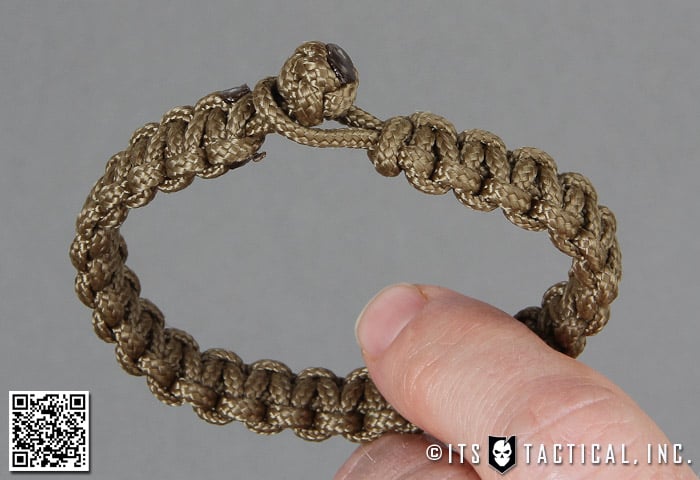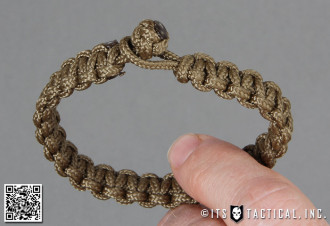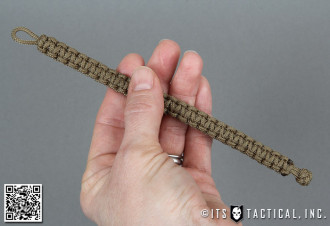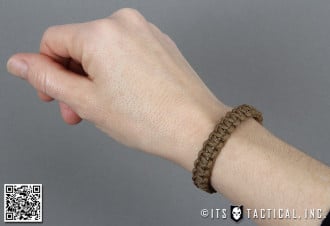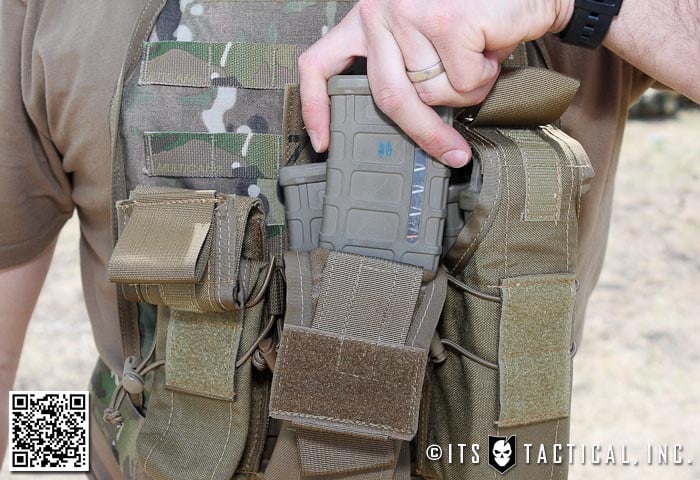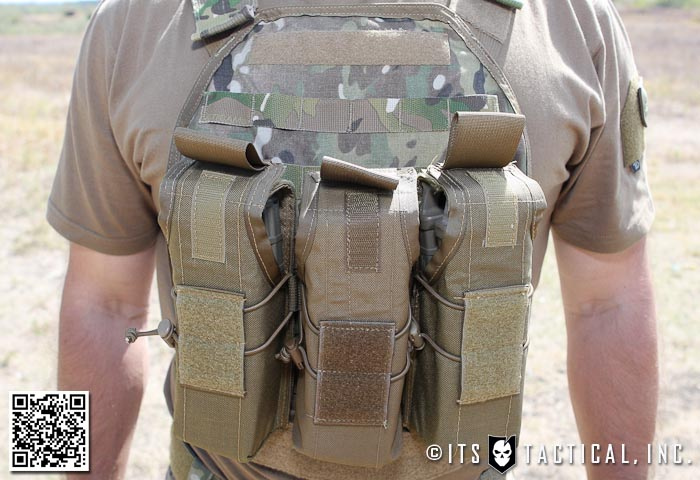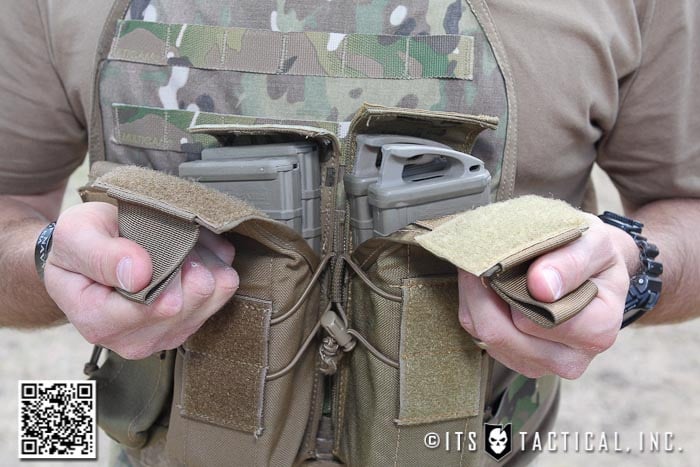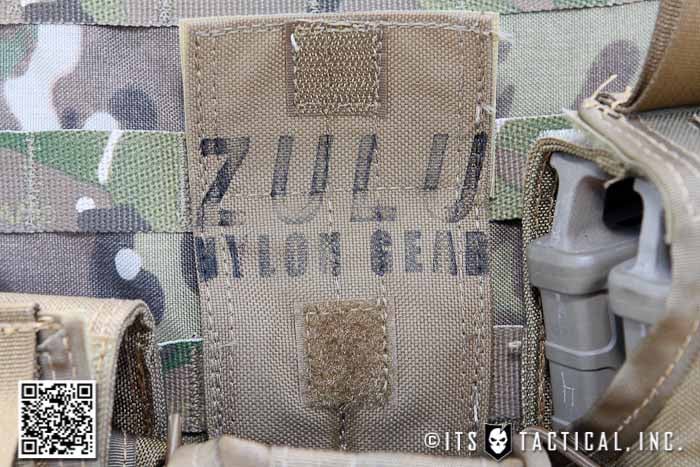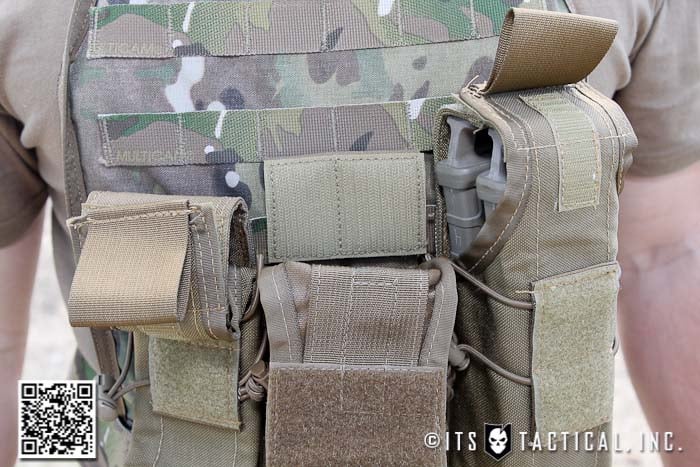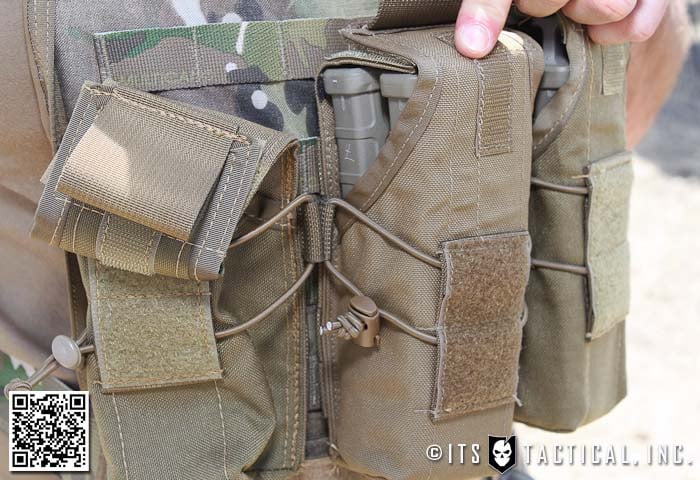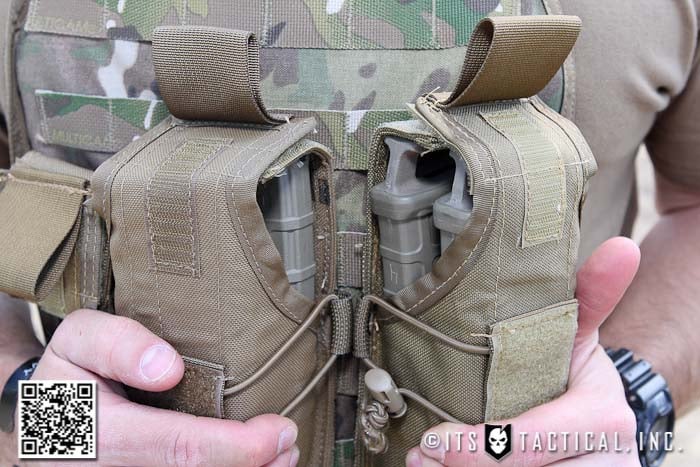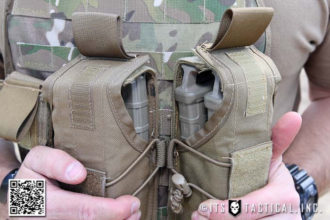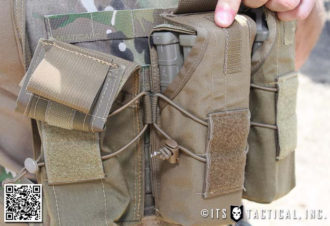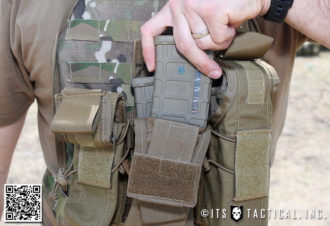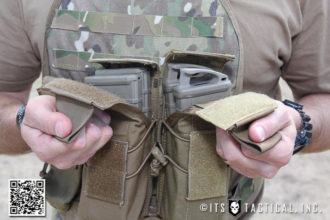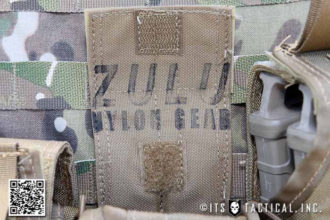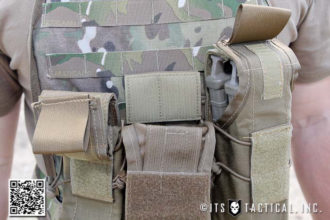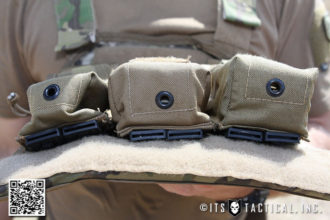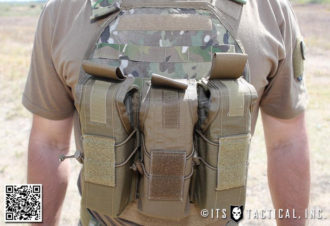 Editor-in-Chief’s Note: This post was written by Brett and Kate McKay and originally ran on The Art of Manliness.
Editor-in-Chief’s Note: This post was written by Brett and Kate McKay and originally ran on The Art of Manliness.
In a previous edition of the Man Knowledge series on Art of Manliness, we discussed the fascinating history of invisible ink. In doing the research for that post, we came across an equally interesting tool in the spy’s bag of tricks: the concealment device.
Invisible ink was handy for sending secret messages, but sometimes spies and soldiers needed to hide other kinds of objects, or simply wanted a double-layer of protection for their coded missives.
Concealment devices or CD’s looked like normal, everyday objects but actually contained a secret compartment or cavity, inside which could be placed film, notes, eavesdropping equipment, and various other types of contraband. They were used to smuggle escape aids to prisoners of war, exchange information with friendlies, monitor the enemy, store secrets for safe keeping, and transport items without arousing suspicion.
Concealment History
The earliest quasi-concealments were used by the ancient Greeks and Romans. The Greek general Histiaeus wrote a message on the head of his servant, waited for his hair to grow back, and sent him on his way. This was, of course, not a very effective method of communicating something that was even remotely time-sensitive.
Roman generals placed secret messages in the bandages wrapped around the limbs of wounded soldiers or sowed a message into the sole of a courier’s sandal. In later centuries, dignitaries hid their correspondence in barrels of beer and hollowed out bullets.
Such rudimentary methods of concealment were used for hundreds of years. But the fabrication of concealment devices really became a high art in the 20th century, particularly during World War II and that Golden Age of Espionage, the Cold War.
Active and Passive Concealment
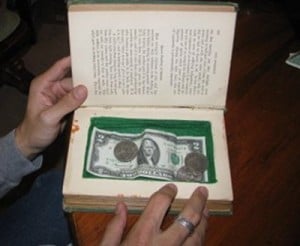 Modern concealment devices can be classified into two categories: active and passive.
Modern concealment devices can be classified into two categories: active and passive.
Active concealments are objects that contain a secret compartment while also retaining their normally intended function. A lamp that you can turn off and on but also contains a secret compartment in its base would fall into this category. An object like a secret book safe, which serves only as a hiding place, is a passive concealment.
Regardless of whether the CD was active or passive, it had to be something that would not arouse suspicion if the agent was searched or scrutinized—an item that the person would normally have in their apartment or carry around.
Concealment devices also had to look indistinguishable from the non-modified versions on which they were modeled. To accomplish this, intelligence agencies like the CIA’s Office of Technical Services created labs capable of fabricating everything from furniture like bookshelves and wine racks, to leather goods like wallets and handbags, to books and electronics—all from scratch. The lab consisted of a myriad of special shops that were each staffed by expert craftsmen—carpenters, leather workers, bookbinders, tailors, seamstresses, and more—who specialized in a certain area of production.
These craftsmen, along with very imaginative technicians, dreamed up and brought to life a variety of extremely clever concealment devices. Here is a look at some of the coolest and manliest of the bunch.
Pipe
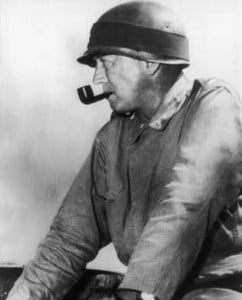 During WWII, a pipe was made with a secret cavity that sat in the pipe’s bowl, right below the compartment that held the tobacco. You could stash your secret message in that cavity, and if you were about to be compromised, you simply twisted the pipe stem and the top compartment opened, allowing the burning embers to destroy the message.
During WWII, a pipe was made with a secret cavity that sat in the pipe’s bowl, right below the compartment that held the tobacco. You could stash your secret message in that cavity, and if you were about to be compromised, you simply twisted the pipe stem and the top compartment opened, allowing the burning embers to destroy the message.
To accomplish a similar task, agents later used flash paper that would instantly and smokelessly burn up when touched by a cigarette. And when smoking became less popular, spies used water-soluble paper that could be dissolved in coffee cups or even swallowed.
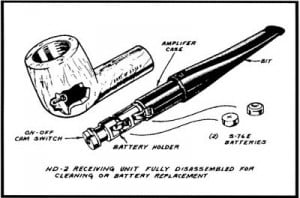 Another pipe used by later spies functioned as a passive concealment; it couldn’t be smoked as it housed a countersurveillance radio. For the agent to listen in on the enemy’s conversations, he merely had to bite down on the stem; sound was conducted through the user’s bones (they currently make swimming headphones that work in a similar way).
Another pipe used by later spies functioned as a passive concealment; it couldn’t be smoked as it housed a countersurveillance radio. For the agent to listen in on the enemy’s conversations, he merely had to bite down on the stem; sound was conducted through the user’s bones (they currently make swimming headphones that work in a similar way).
Playing Cards
If a pilot was shot down and taken prisoner, but hoped to escape, he needed to know the lay of the land—where he was and how to get to safety. Thus secret maps were an important tool for the fighting man. But paper maps were hard to hide; they crinkled if you were getting a pat down. So Christopher Clayton Hutton, working for the British MI9, came up with the idea of printing maps on pieces of silk.

The maps were sewn into the lining of pilots’ bomber jackets, stashed inside a secret compartment in the heels of their boots, or rolled up inside pencils and even cigars. Hutton also created maps on a special tissue paper made from Mulberry leaves. It had the consistency of onion skin, but was very durable and could be soaked and folded without becoming damaged or creased.
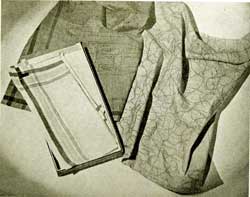 These tissue paper maps were sandwiched between the fronts and backs of playing cards, and could be revealed by wetting the cards and peeling them apart. Each of the 52 cards contained a segment of the map, while the Jokers included the code for how to put the pieces together. Maps were also printed invisibly on handkerchiefs and could only be revealed when soaked in a certain chemical.
These tissue paper maps were sandwiched between the fronts and backs of playing cards, and could be revealed by wetting the cards and peeling them apart. Each of the 52 cards contained a segment of the map, while the Jokers included the code for how to put the pieces together. Maps were also printed invisibly on handkerchiefs and could only be revealed when soaked in a certain chemical.
Compass (Various Forms)
Even if a POW had a secret map at his disposal, without a compass, getting back to safety would have been a challenge. Thus hidden compasses were one of the most popular concealments during WWII, and they took a variety of forms. Compasses were hidden in pipes, brass buttons, bars of soap, and even un-shelled walnuts.

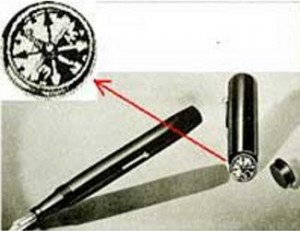
Innocuous-looking items were also made with parts that could function as compasses in a pinch; for example, the clip of a pencil was magnetized and when removed and balanced on the pencil’s tip, would point north.
A tiny compass concealed in a fountain pen. The nib and clip were also magnetized and could function as compasses when suspended from a thread. Other escape pens held maps, currency, and dye to color clothing,
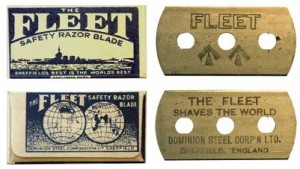 These standard-looking razor blades contained magnetic needles. When the razors were placed in a cup of water, they would spin so that the arrows pointed north.
These standard-looking razor blades contained magnetic needles. When the razors were placed in a cup of water, they would spin so that the arrows pointed north.
Board Games
 The British company that produced the aforementioned silk maps, John Waddington LTD., also happened to own the rights to produce the American Parker Bros. game, Monopoly, in the UK. German prisoner of war camps accepted items that fell into the category of games and amusements, and so Waddington’s expanded their concealment device catalog to include rigged Monopoly games.
The British company that produced the aforementioned silk maps, John Waddington LTD., also happened to own the rights to produce the American Parker Bros. game, Monopoly, in the UK. German prisoner of war camps accepted items that fell into the category of games and amusements, and so Waddington’s expanded their concealment device catalog to include rigged Monopoly games.
The game board was created with slight indentations which were filled with low-profile compasses, files, and maps. The board and these depressions were then covered over with the printed label. Also, sandwiched between the fake Monopoly money was real currency from Germany and surrounding countries for the men to use on the lam. Recipients of the games were alerted to the fact that the game was a rigged one by a small red dot on the free parking square.
Monopoly boards were not the only games used as concealment devices. Shortwave radios were smuggled in inside hollowed out cribbage boards as well.
While it is commonly thought that these rigged games were delivered by the Red Cross, the supplies from that organization were too vital to risk the Germans discovering the deceit and thus having a reason to refuse their packages. The games were actually given through fictitious charitable groups that were made up for the express purpose of smuggling contraband.
Shoes and Boots
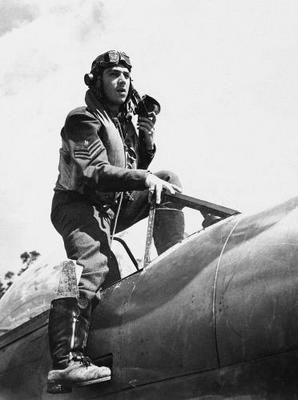 A shoe with a hollowed out heel is one of the oldest and simplest concealment devices. The first heel compartment was created in 1901, and Houdini used them to hide keys for his escapes.
A shoe with a hollowed out heel is one of the oldest and simplest concealment devices. The first heel compartment was created in 1901, and Houdini used them to hide keys for his escapes.
During the war, Clayton Hutton designed flying boots for RAF pilots that had a secret compartment in the heel, inside which could be stashed small food packets or maps. The leggings could be removed as well, turning the boots into civilian-looking brogues.
Hutton also stuck cheese wire into the laces of other shoes for the prisoners to use in cutting through metal bars.
Shaving Cream and Brush
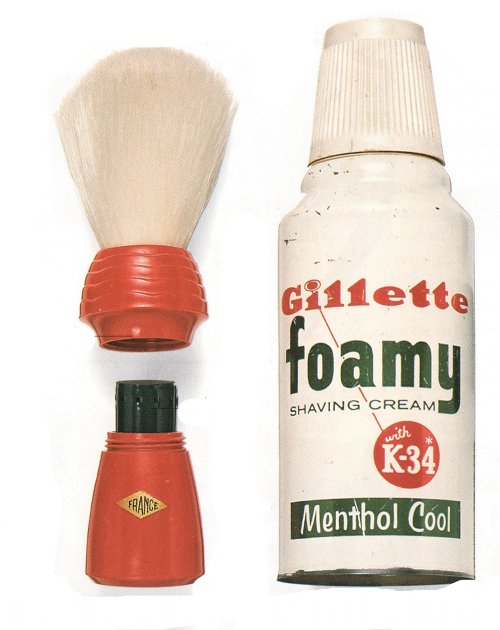 The items contained in mess kits were good candidates for concealment devices as they seemed very ordinary for a solider to be carrying, and they would be accepted into POW camps.
The items contained in mess kits were good candidates for concealment devices as they seemed very ordinary for a solider to be carrying, and they would be accepted into POW camps.
Shaving cream and toothpaste tubes concealed capsules which contained messages or maps. The top of the tube contained a bit of cream so that if the tube was tested, it would appear to be a normally-functioning item.
Metal shaving cream cans were made with false bottoms that included a secret compartment. (Such “diversion cans” are still sold as household secret safes.) And shaving brushes with hollow handles could be used by spies to hide a roll of film.
False Scrotum
Picture thankfully unavailable
In the 1960s, a false rubber scrotum was developed which hid a sub-miniature escape radio and was placed over an agent’s real scrotum. It was a very safe concealment; even during a strip-search, inspectors were unlikely to give an agent’s balls a very close look.
Automobile
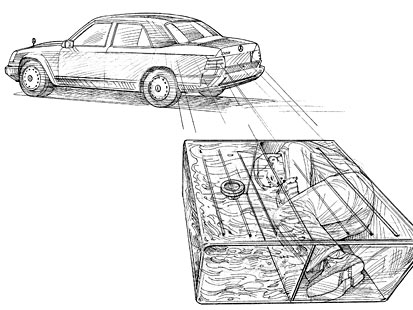
During the Cold War, the CIA altered cars so that the fuel tank was smaller, and the remaining cavity could be used to stash a spy they were smuggling out of a country.
Combustible Notebook
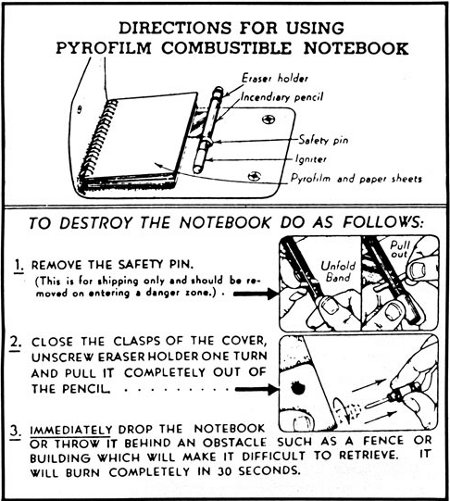
The combustible notebook isn’t really a concealment device per se, but it’s so cool we had to include it. Pull out the pin and it starts to combust, like a smoldering grenade. I would have loved to have taken notes for my college classes in one of these and then removed the pin after finals to watch it burn.
Cork
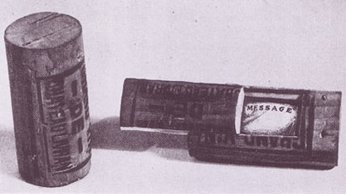
A bottle of wine was an ordinary thing to bring to a function and exchange with someone else, and the cork was very unlikely to be inspected.
Dead Animals
 The “dead drop” method was used when secret agents wished to exchange information without ever meeting in person. One agent would drop off a concealment device on the side of the road or in a public park, and another agent would come by later and casually pick it up. Because they were left in public places, dead drop concealments had to be made from things that would fit into the area and wouldn’t entice other people to take or even touch them. Thus, the more repulsive a dead drop concealment, the better. So while hollowed out bricks, tree limbs, and soda cans were sometimes used, animal carcasses were the most popular vehicle for this espionage tactic.
The “dead drop” method was used when secret agents wished to exchange information without ever meeting in person. One agent would drop off a concealment device on the side of the road or in a public park, and another agent would come by later and casually pick it up. Because they were left in public places, dead drop concealments had to be made from things that would fit into the area and wouldn’t entice other people to take or even touch them. Thus, the more repulsive a dead drop concealment, the better. So while hollowed out bricks, tree limbs, and soda cans were sometimes used, animal carcasses were the most popular vehicle for this espionage tactic.
The animals were killed, gutted, and sometimes freeze-dried. A cavity was prepared and closed up with velcro. The animal could be placed in a can and given to the agent to be used at the appropriate time. When that time came, the animals were stuffed with anything from code books to cameras, velcroed shut, and dropped off. The agent might also add some realistic-looking OTS-crafted rodent guts to the scene to up the yuck factor.
Of course while people might steer clear of the cadaverous critter, such a find was a cat’s delight. So the rodents were often sprinkled with hot sauce as a deterrent to kitty depositing a mouse with state secrets at someone’s doorstop.
The animal carcass dead drop was so effective it was still in use up until a decade or so ago.
Gentleman’s Clothing Brush
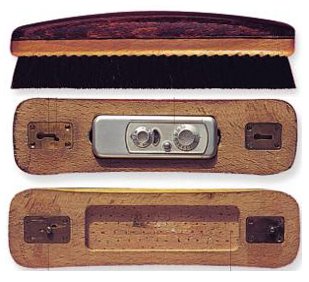 With its small size and close-focusing lens (the better to copy documents with), the Minox camera was popular in espionage circles and hidden in a variety of concealment devices, like this gentleman’s clothing brush.
With its small size and close-focusing lens (the better to copy documents with), the Minox camera was popular in espionage circles and hidden in a variety of concealment devices, like this gentleman’s clothing brush.
The two halves of the brush discreetly locked together and could only be unfastened by inserting a pin into a camouflaged hole.
Skeleton Key

As if skeleton keys weren’t cool and mysterious enough to begin with….
Lighter
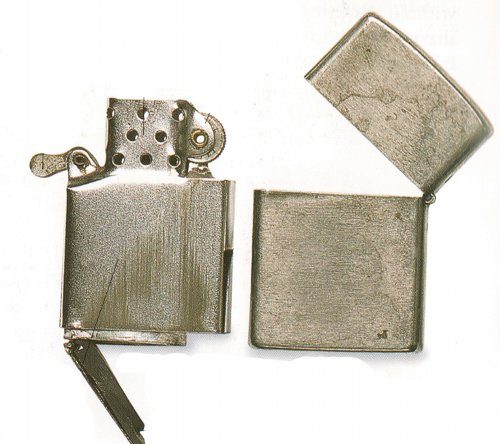 Lighters were very common items for a mid-century man to be carrying around, so it was a perfect candidate for transformation into a concealment device. Some, like the lighter above, were made with special bottoms that held a small secret cavity.
Lighters were very common items for a mid-century man to be carrying around, so it was a perfect candidate for transformation into a concealment device. Some, like the lighter above, were made with special bottoms that held a small secret cavity.
And in the 70s, as technology got better and listening devices got smaller, eavesdropping equipment was moved from large passive concealments like bricks to small active concealments like lighters.
Hollow Coins
 Hollow coins were first used by Soviet agents in the 1930s to conceal microdots, soft film, and ciphers. Americans discovered the ruskie’s ingenuity in 1953, when a paperboy in Brooklyn dropped a nickel that surprisingly split open when it hit the ground to reveal a secret compartment within.
Hollow coins were first used by Soviet agents in the 1930s to conceal microdots, soft film, and ciphers. Americans discovered the ruskie’s ingenuity in 1953, when a paperboy in Brooklyn dropped a nickel that surprisingly split open when it hit the ground to reveal a secret compartment within.
The coins had been traded back and forth between Soviet spies operating in New York City.
Other countries, including the US, used the hollow coin concealment as well. The reusable coins consisted of two pieces that were screwed together in a virtually undetectable way. To open the coin, you had to press and turn your thumb on the face of it (on the coin above from 1978, you pressed the tip of the eagle’s wing).
The incident with the paperboy reveals one of the downsides of the hollow coin concealment; since they look and feel just like regular coins, they were easy to lose, drop, and accidentally spend. Thus there could very well still be some out there in circulation (better check your piggy bank!)
Sources:
Editor-in-Chief’s Note: The Art of Manliness is a fantastic Website dedicated to uncovering the lost art of being a man. It features articles on helping men be better husbands, better fathers, and better men. Check them out and be sure to subscribe!






 Editor-in-Chief’s Note: This post was written by Brett and Kate McKay and originally ran on
Editor-in-Chief’s Note: This post was written by Brett and Kate McKay and originally ran on 



 These tissue paper maps were sandwiched between the fronts and backs of playing cards, and could be revealed by wetting the cards and peeling them apart. Each of the 52 cards contained a segment of the map, while the Jokers included the code for how to put the pieces together. Maps were also printed invisibly on handkerchiefs and could only be revealed when soaked in a certain chemical.
These tissue paper maps were sandwiched between the fronts and backs of playing cards, and could be revealed by wetting the cards and peeling them apart. Each of the 52 cards contained a segment of the map, while the Jokers included the code for how to put the pieces together. Maps were also printed invisibly on handkerchiefs and could only be revealed when soaked in a certain chemical.



 A shoe with a hollowed out heel is one of the oldest and simplest concealment devices. The first heel compartment was created in 1901, and Houdini used them to hide keys for his escapes.
A shoe with a hollowed out heel is one of the oldest and simplest concealment devices. The first heel compartment was created in 1901, and Houdini used them to hide keys for his escapes. The items contained in mess kits were good candidates for concealment devices as they seemed very ordinary for a solider to be carrying, and they would be accepted into POW camps.
The items contained in mess kits were good candidates for concealment devices as they seemed very ordinary for a solider to be carrying, and they would be accepted into POW camps.


 The “
The “ With its small size and close-focusing lens (the better to copy documents with), the Minox camera was popular in espionage circles and hidden in a variety of concealment devices, like this gentleman’s clothing brush.
With its small size and close-focusing lens (the better to copy documents with), the Minox camera was popular in espionage circles and hidden in a variety of concealment devices, like this gentleman’s clothing brush.
 Lighters were very common items for a mid-century man to be carrying around, so it was a perfect candidate for transformation into a concealment device. Some, like the lighter above, were made with special bottoms that held a small secret cavity.
Lighters were very common items for a mid-century man to be carrying around, so it was a perfect candidate for transformation into a concealment device. Some, like the lighter above, were made with special bottoms that held a small secret cavity.
